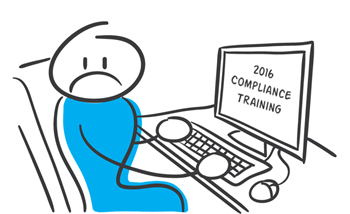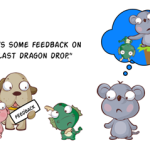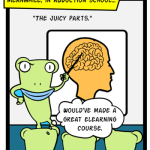Third pain point: Learner isn’t given adequate time or they don’t give themselves enough time to review the e-learning lesson, and so want to hurry up and click-thru everything so that they can show they’ve done it. They’re not invested in the learning aspect of the lessons.
How to Avoid These Three Pain Points for Online Learning
May 17th, 2016
The other day someone asked what I thought the three top pain points were for online training or elearning. I hear lots of complaints and I’m sure that there are many pain points, however if we keep them in perspective, they’re really not as painful as being stabbed or thrown down a flight of stairs. Here are some of the issues I find most challenging with elearning.
E-Learning Pain Point #1: Courses are Boring
I review a lot of courses during the year. Many of them are very basic–consisting of mostly slides, simple graphics, and bullet points. I’ll assume that the people who do take the courses probably don’t find then all that exciting. A slide with bullet point content isn’t necessarily a bad thing. However, slide after slide of this type of content isn’t the most effective way to engage and teach people.
The bigger issue isn’t usually the content as much as it is that the content isn’t relevant to the person’s needs. Here are a few tips to help.
- The solution is to reframe the content so it’s relevant to the learner. Talk with your potential audience and find out where the content comes into play with their daily roles. Then convert the bullet points into more meaningful content.
- Ideally you’re able to align the content and learning objectives to the appropriate activities.
- Worst case, start with a case study to convert the content into a meaningful story.
E-Learning Pain Point #2: Developers Have Limited Skills & Resources
Many of the people I meet are the only elearning person on staff. And the majority of them didn’t start in elearning. They started as trainers who moved to elearning as the organization needed to put courses online. They end up having to do everything from instructional design, graphic design, and course authoring.
In addition to having limited experience building elearning courses, they usually lack a breadth of technical knowledge and programming skills. On top of that, they don’t get adequate support for other things such as media assets and IT help.
Many of them do a great job given their limited resources, but to build courses that are engaging, interactive, and meet learning objectives requires more than a basic understanding of PowerPoint and learning to find free clip art. This means that the developers need time to learn the skills to build more than basic courses and they need more support from their organizations.
Without organizations making a bigger commitment to their elearning teams, most courses will probably be stuck in pain point #1.
Here are some solutions for those who want to learn more and do more:
- Check out all of the free getting started resources we have in the community. There’s a lot of good generic content, free ebooks, and of course tutorials to learn the software.
- Participate in the weekly challenges to practice new things. Even if you don’t participate, make it a point to see what others do as a source of inspiration.
- Take classes where you can. You can go for a formal degree or certificate at most of the universities. There are informal options like the video tutorials, lots of free webinars, and a number of opensource learning opportunities. And of course, participate in your local ATD, ISPI, and STC chapters.
- Read a book and apply what you learn to your courses (or the weekly challenges). Here’s a good starting list. Or better yet, create a mini module on what you learned in the book and share it with others. It’s a great way to practice building courses–solidifying the content in your own brain and sharing what you learn with others.
E-Learning Pain Point #3: [Insert pain point here]
I can add an assortment of additional pain points such as courses are too long, high dropout rates, etc. But I’d like to open it up to you. What is the single biggest pain point for you when it comes to elearning and online training? Add your thoughts in the comments section.
Events
- Everyday. Check out the weekly training webinars to learn more about Rise, Storyline, and instructional design.
Free E-Learning Resources
 |
 |
 |
|
Want to learn more? Check out these articles and free resources in the community. |
Here’s a great job board for e-learning, instructional design, and training jobs |
Participate in the weekly e-learning challenges to sharpen your skills |
 |
 |
 |
|
Get your free PowerPoint templates and free graphics & stock images. |
Lots of cool e-learning examples to check out and find inspiration. |
Getting Started? This e-learning 101 series and the free e-books will help. |
26 responses to “How to Avoid These Three Pain Points for Online Learning”
Pain Point #3 for me would be getting relevant feedback from SMEs and/or stakeholders in a timely fashion. Either I get a laundry list at the last minute of things to change (ranging from valid to purely subjective), or I get an answer after 3 minutes saying, “Looks great!” Did they really even look at it?
Lack of Quality – this could tie back into your point #2, where the developer has less than optimum grammatical and spelling skills. Or it can be caused by someone rushing to meet a deadline. But in my experience, most often it’s caused by someone who just doesn’t care to focus on the details. Reminds me of an old saying “the devil is in the details.” That applies to presentations. Perhaps some students don’t notice it, but for those who do, a badly worded sentence, a misspelled word, or inconsistency of capital letters vs. lower case can so distract the learner that they fail to absorb whatever training is being offered.
Nothing annoys me more than a TV ad or news program with annoying quality. I can honestly say I don’t hear another word said.
Pain Point = Time. I work in the community college environment where the content is often provided as PowerPoint presentations from the publishers and professors have no time to customize. (Faculty developers work alongside IDs). Faculty rely on the publishers to ensure that the learning Objectives in the text match the questions in the quizzes (LO alignment with text, is checked as the text is usually already used in a F2F course). Most activities are discussions and quizzes. If they use publisher provided resources like McGraw Hill CONNECT or Cengage Brain, the students benefit from the interactive activities but not the cost. Professors are usually not too keen on using these because of the cost to the students.
IDs are strapped for time (overseeing over 50 courses per semester). Another challenge is SMEs (Faculty) do not let IDs into their process of designing the course until late in the game (organizational problem …..trust issue).
These challenges won’t change overnight. I know. Help me with some tips, anyone!!
M
Nummer Drei: Unrealistic expectations from stakeholders, either regarding timeline or impact a one-off elearning course is likely to have.
Pain Point: Not understanding learner’s computer savvy, also known as…Don’t Make Assumptions! Yes, there are still people who don’t have a lot of computer skills. That very cool, drag and drop activity with sound effects you lovingly created may be lost on someone who rarely uses a computer. Yes, there are workgroups and places where people don’t use computers on a daily basis! Know your audience and what level of sophistication will help them the most.
Pain Point #3: Timing; need I say it again; TIMING! Designers must take into consideration the amount of content they inject into the presentation, especially those who have a tendency of getting really fancy with their animation, transitions, floating in bullet points, and the list goes on and on! When you are in a virtual environment and have only so much time to deliver the content, without sounding rushed, and don’t have time to engaged attendees on the subject matter, because you, the facilitator are so focused on where you should be based on their perception of time. God forbid you have the stakeholder listening in on the call, along with the designer and the designer keeps IMing you to “speed up, you are very far behind!” 4 – 5 times in a row…
Any ideas on how to over come this without having to redo the designer’s work? Which I’m getting ready to do right now…lol
Pain Point #3 for me is having to create courses that are extremely wordy. I am not able to use audio when creating courses so courses become word heavy. I try to avoid this by creating courses that have some interaction with the learner.
good to be good see good thing for you and me
Quality – That is, the quality of material provided by SME’s. Often it is either excessive, forcing you to have to go back and get them to break it down to what is actually wanted in the course or it is incomplete. The result is courses that don’t fully meet the needs of our learners.
Follow-up – Pain Point #2 – As a “self taught” instructional designer it is a constant struggle to grow the needed skills sets while trying to produce quality course content. My “go to” source for help and knowledge is this community. Thanks Tom and everyone else who freely gives to help support us all.
Scope creep especially when the client proposes a task one day before release that will take three days to complete.
My Pain Point #3 is that I do not own any E-Learning software. How can I get started without buying software? I welcome any suggestions you have. Thanks!
Pain Point#3 – the client was determined about how they wanted their elearning to look and the content… until they see it in action!
LOW COMPLETION RATES when the training is not compulsory. Unless participants are in a classroom and being directed to do it, I find it difficult to get participants to complete the training in their own time (including on the job!)
La traduzione in italiano (autorizzata) è disponibile qui: http://www.mosaicoelearning.it/blog/tre-punti-dolenti-delle-learning/
For me, the worst is that most e-learning courses are only theory. Long or short -usually very long- they’re only composed of theory + theory + theory + test, even if this is displayed as video + text + downloadable PDF + test…
Apart from the ones that you have mentioned, mine is too much content with little or no interactivity at all.
Pain point #3 E-learning that has to be repeated on a regular basis (e.g. for compliance with the law), yet takes no account of an employee’s existing knowledge and understanding, so they have to do the exact same training over and over again.
Pain Point #3: My clients suddenly believe they are experts with design and start dictating what I would consider poor quality eLearning. This is a struggle for me. They are the subject matter experts, and please allow me to be the expert with eLearning design. Also, my client continues to make changes after initial storyboard was approved.
I echo Di Hickman’s pain point. For me, this pain point is connected to using a learning management system that is not user friendly and looks like it was designed circa 1995.
I am going to suggest:
3) Content is too long and doesn’t provide a cohesive learner experience from within the LMS
Long elearning courses (when I say ‘long’ I mean 15 minutes plus) built in rapid authoring software like Storyline do not lend themselves to learner engagement.
Think about YouTube – how often do you watch a 20 minute YouTube video? Not often I bet, but you’ll watch hundreds of 2-minute videos.
So thinking carefully about how the learner interacts with the content and viewing one long course when 12 smaller modules might be better is definitely a pain point for many learners.
I wrote an article about this exact subject: http://bit.ly/not-enough-2016
Pain point 3: When you SME sees the online learning environment as a place to dump information, and loses the users perspective on what it will be actually like to undertake the course.
Thanks for this posting. I am very impressed with it, sure this is one of the best articles.The article that is mentioned in the blog is good. we getting nice information through this blog. It’s very helpful
A thought provoking post that seems to have captured the feelings elearning developers/instructional designers.I would say Pain point #3 is when you have problems logging to an online course that has unfocused, poor and unstructured content.









0
comments